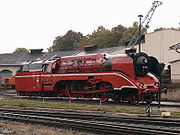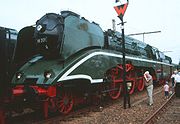
DR 18 201
Encyclopedia
The German express locomotive, number 18 201 of the Deutsche Reichsbahn in East Germany, appeared in 1960-61 at Meiningen repair shop as a conversion of the Henschel-Wegmann train
locomotive 61 002
, the tender from 44 468
and parts of H 45 024 and Class 41
. It is the fastest operational steam locomotive
in the world.
urgently needed locomotives that could do at least 160 km/h in order to test passenger coaches.
For the conversion a DR Class 22
new-design boiler, parts of the unsuccessful high pressure locomotive, H 45 024, (outside cylinders, trailing wheels and rear section of the locomotive frame
) as well as the tender of locomotive 44 468 were used. The inside cylinder of the three-cylinder engine was not however taken from 61 002, rather a new one was made. Other technical improvements were a Riggenbach
counterpressure brake and a Giesl ejector
. The locomotive was streamlined at the front and over the boiler fittings.
The new locomotive was given its number to commemorate the first German locomotive with a 4-6-2
('Pacific') wheel arrangement, the Baden IV f of the Baden State Railways (later the DRG Class 18.2).
 In 1967 number 18 201 was converted to oil-firing. After the changeover to computerised numbers the engine was given the number 02 0201-0. On 11 October 1972 during a trial run it attained a top speed of 182,4 km/h. As a result it is the fastest, operational steam locomotive in the world, and also holds the world record for the biggest driving wheels (2.30 m in diameter) ever to be fitted to an engine with a 4-6-2 wheel arrangement.
In 1967 number 18 201 was converted to oil-firing. After the changeover to computerised numbers the engine was given the number 02 0201-0. On 11 October 1972 during a trial run it attained a top speed of 182,4 km/h. As a result it is the fastest, operational steam locomotive in the world, and also holds the world record for the biggest driving wheels (2.30 m in diameter) ever to be fitted to an engine with a 4-6-2 wheel arrangement.
When not required for test runs, locomotive 18 201 was also put in charge of scheduled express trains until well into the 1970s.
 Since 1980 the locomotive has mainly been employed to haul heritage and special trains, often with a second tender, in order to be able to complete long-distance runs without the need to replenish its water. At its birthplace in Meiningen Steam Locomotive Works
Since 1980 the locomotive has mainly been employed to haul heritage and special trains, often with a second tender, in order to be able to complete long-distance runs without the need to replenish its water. At its birthplace in Meiningen Steam Locomotive Works
the engine was handed over to the firm of Dampf-Plus on 4 April 2002 having been completely overhauled. Originally sporting a green livery with white stripes, the engine was repainted between 30 April 2002 and 10 July 2005 in a special red livery (RAL 3003, ruby red) sponsored by the model railway manufacturer, Roco
. Today she is once again painted in her traditional green colour (RAL 6020, chromium oxide green).
, owners of the Dampf-Plus company. Up to January 2006, the locomotive was the subject of a dispute between its owners and the Deutsche Bahn AG, and a sale abroad was contemplated (even the USA and Canada were discussed).
 18 201's last special run before took place on 16 July 2005 followed by several months when it was out of service. The special red livery was - as always intended - replaced by the original green paintwork.
18 201's last special run before took place on 16 July 2005 followed by several months when it was out of service. The special red livery was - as always intended - replaced by the original green paintwork.
On 31 January 2006 the newspaper, Sächsische Zeitung, reported that the guardians of this historic Halle monument were permitting the engine to be stationed elsewhere for a length period; but this did not mean that its export was planned. Meanwhile the locomotive is stabled at Nossen
.
At the celebration of the Schiefe Ebene
's 160 years in September 2008 organised by the German Steam Locomotive Museum
at Neuenmarkt
, 18 201 was finally back in action.
Henschel-Wegmann Train
The Henschel-Wegmann Train was a unique passenger express train operated by the Deutsche Reichsbahn in Germany, which ran non-stop express services between Berlin and Dresden from June 1936 to August 1939...
locomotive 61 002
DRG Class 61
The two German DRG Class 61 steam engines were express train locomotives specifically built by Henschel for the Henschel-Wegmann train in service with the Deutsche Reichsbahn...
, the tender from 44 468
DRG Class 44
The Class 44 was a ten-coupled, heavy goods train steam locomotive built for the Deutsche Reichsbahn as a standard steam engine class . Its sub-class was G 56.20 and it had triple cylinders...
and parts of H 45 024 and Class 41
DRG Class 41
The German Class 41 steam locomotives were standard goods train engines operated by the Deutsche Reichsbahn and built from 1937 - 1941.- History :...
. It is the fastest operational steam locomotive
Steam locomotive
A steam locomotive is a railway locomotive that produces its power through a steam engine. These locomotives are fueled by burning some combustible material, usually coal, wood or oil, to produce steam in a boiler, which drives the steam engine...
in the world.
Origin
The motivation for the conversion was firstly that, as a one-off, locomotive 61 002 could not really be used for scheduled services, and secondly that the research institute at VES-M HalleVES-M Halle
The Versuchs- und Entwicklungsstelle Maschinenwirtschaft in Halle, Germany, was a railway research and development department working for the engineering head office of the Deutsche Reichsbahn in East Germany after the Second World War...
urgently needed locomotives that could do at least 160 km/h in order to test passenger coaches.
For the conversion a DR Class 22
DR Class 22
The steam locomotives of DR Class 22 were reconstructed passenger train locomotives in service with the Deutsche Reichsbahn in East Germany after the Second World War....
new-design boiler, parts of the unsuccessful high pressure locomotive, H 45 024, (outside cylinders, trailing wheels and rear section of the locomotive frame
Locomotive frame
A locomotive frame is the structure that forms the backbone of the railway locomotive, giving it strength and supporting the superstructure elements such as a cab, boiler or bodywork. The vast majority of locomotives have had a frame structure of some kind...
) as well as the tender of locomotive 44 468 were used. The inside cylinder of the three-cylinder engine was not however taken from 61 002, rather a new one was made. Other technical improvements were a Riggenbach
Riggenbach
Riggenbach can refer to:*Albert Riggenbach, meteorologist*Niklaus Riggenbach, inventor*Riggenbach counter-pressure brake*Riggenbach rack system*Holly Black née Riggenbach*Riggenbach's gerbil...
counterpressure brake and a Giesl ejector
Giesl ejector
A Giesl ejector is a suction draught system for steam locomotives that works on the same principle as a feedwater pump.This ejector was invented in 1951 by the Austrian engineer, Dr. Adolph Giesl-Gieslingen. The Giesl ejector ensures improved suction draught and a correspondingly better use of...
. The locomotive was streamlined at the front and over the boiler fittings.
The new locomotive was given its number to commemorate the first German locomotive with a 4-6-2
4-6-2
4-6-2, in the Whyte notation for the classification of steam locomotives, represents the wheel arrangement of four leading wheels on two axles , six powered and coupled driving wheels on three axles, and two trailing wheels on one axle .These locomotives are also known as Pacifics...
('Pacific') wheel arrangement, the Baden IV f of the Baden State Railways (later the DRG Class 18.2).

When not required for test runs, locomotive 18 201 was also put in charge of scheduled express trains until well into the 1970s.
Duties as a heritage locomotive

Meiningen Steam Locomotive Works
The Meiningen Steam Locomotive Works is a railway repair shop in Meiningen, Germany. It is owned by Deutsche Bahn and has specialised in the maintenance of museum steam locomotives since 1990, having extensive experience in maintaining steam engines. Today, customers of the factory include...
the engine was handed over to the firm of Dampf-Plus on 4 April 2002 having been completely overhauled. Originally sporting a green livery with white stripes, the engine was repainted between 30 April 2002 and 10 July 2005 in a special red livery (RAL 3003, ruby red) sponsored by the model railway manufacturer, Roco
Roco
Roco, based in Salzburg, Austria, is a manufacturer of model railway equipment.-History:The company was founded in 1960 by Ing. Heinz Rössler and started with a plastic Minitanks series. After export to the USA became successful, the model line was expanded with model trains in H0 scale and the...
. Today she is once again painted in her traditional green colour (RAL 6020, chromium oxide green).
18 201 today
Locomotive 18 201 belongs to Christian Goldschagg and Axel ZwingenbergerAxel Zwingenberger
Axel Zwingenberger is a blues and boogie-woogie pianist, and songwriter. He is considered one of the finest boogie-woogie music masters in the world.-Biography:...
, owners of the Dampf-Plus company. Up to January 2006, the locomotive was the subject of a dispute between its owners and the Deutsche Bahn AG, and a sale abroad was contemplated (even the USA and Canada were discussed).

On 31 January 2006 the newspaper, Sächsische Zeitung, reported that the guardians of this historic Halle monument were permitting the engine to be stationed elsewhere for a length period; but this did not mean that its export was planned. Meanwhile the locomotive is stabled at Nossen
Nossen
Nossen is a town in the district of Meißen, in the Free State of Saxony, Germany. It is part of the Dresden region, and located 80 km southeast of Leipzig. The town is dominated by a large Renaissance castle.- History :...
.
At the celebration of the Schiefe Ebene
Schiefe Ebene
The Schiefe Ebene is a steep railway incline on the course of the Ludwig South-North Railway from Bamberg to Hof in the region of Upper Franconia, in Bavaria, Germany....
's 160 years in September 2008 organised by the German Steam Locomotive Museum
German Steam Locomotive Museum
The German Steam Locomotive Museum or DDM is located at the foot of the famous Schiefe Ebene ramp on the Ludwig South-North Railway in Neuenmarkt, Upper Franconia. This region is in northern Bavaria, Germany...
at Neuenmarkt
Neuenmarkt
Neuenmarkt is a municipality in the district of Kulmbach in Bavaria in Germany.-City arrangement:Neuenmarkt is arranged in the following boroughs:...
, 18 201 was finally back in action.
See also
- Deutsche ReichsbahnDeutsche ReichsbahnDeutsche Reichsbahn was the name of the following two companies:* Deutsche Reichsbahn, the German Imperial Railways during the Weimar Republic, the Third Reich and the immediate aftermath...
- Deutsche Reichsbahn (East Germany)
- List of East German Deutsche Reichsbahn locomotives and railbuses
- List of DRG locomotives and railbuses
- List of preserved steam locomotives in Germany
Literature
- Weisbrod, Bäzold, Obermayer: Das große Typenbuch deutscher Lokomotiven. Transpress Verlag, ISBN 3-344-70751-5
- Wilhelm Reuter: Rekordlokomotiven. Motorbuch Verlag, Stuttgart, ISBN 3-87943-582-0
External links
- http://www.dampflokwerk.de/deutsch/special18201.htm
- http://www.dampf-plus.de
- http://www.18201-stiftung.de
- There is a relevant English-language forum at Railways of Germany

